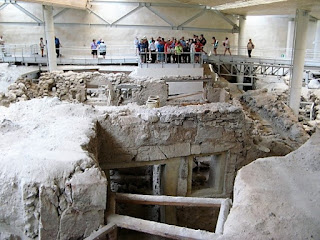Wikipedia:
"Akrotiri was a Cycladic Bronze Age settlement on the volcanic Greek island of Santorini (Thera).
It was destroyed in the Theran eruption sometime in the 16th century BC and buried in volcanic ash, which preserved the remains of fine frescoes and many objects and artworks. Akrotiri has been excavated since 1967."
We were very impressed with the actual dig. It has been closed for the past seven years while walkways were added. The site was also covered with a custom cover that opens and closes as needed. There was air conditioning, too. It was beautiful and easy to navigate. There were two sets of stairs—one down into the street level and one back up to the walkway. Bill waited on the walkway and read all the signs while I went down into the dig with the guide but that was only for about ten minutes.
This site is well worth seeing. I thought it was a remnant of the Minoan culture but the guide said no. (Later, I looked it up and Santorini is considered to be a colony of the Minoan culture on Crete.) These people were excellent sailors and obviously familiar with Egypt and other spots on the Mediterranean. They had murals showing African animals such as blue monkeys that never lived on the island.
This was a culture that worshiped goddesses. The murals show well dressed, light skinned women with jewelry and other signs of wealth. The men are depicted as almost naked and tan all over, presumably from sailing, farming and other outdoor work.
Akrotiri was a small village with four story homes and public buildings. There is a big square lined with shops. There were murals in all the buildings. These were in excellent shape but have been removed for their protection and stored in climate controlled conditions. There is a museum where you can see copies.
Some buildings had toilets connected to sewers. The sewers ran under the streets. They had stone buildings with windows and a roof for sleeping outside in the cool air. They had window systems and thick walls to keep their buildings cool. They had tables carved of wood. They had items made of gold. Remember, this site was destroyed about 3500 years ago.
Akrotiri was destroyed by a volcanic eruption but, unlike Pompeii, there was no one left in the city when the eruption covered the town with many feet of ash. There was a major earthquake before the eruption and everyone left. They apparently took most of their furniture and personal items. There were a few beds and other personal items still on the site. No one knows where they went.
This is the building that was erected over the site.

.JPG)

















